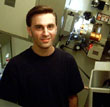|
|
This topic comprises 2 pages: 1 2
|
|
Author
|
Topic: Can modern mylar film replicate "nitrate glow"?
|
|
|
|
|
|
|
|
|
Leo Enticknap
Film God

Posts: 7474
From: Loma Linda, CA
Registered: Jul 2000
|
 posted 11-05-2001 10:37 AM
posted 11-05-2001 10:37 AM





I've always understood the 'nitrate look' to be caused by the higher silver concentration in the emulsion than to the optical properties of the base itself.About 3 years ago I saw a nitrate IB print of 'The Life and Death of Colonel Blimp' at the NFT in London and remembered thinking that the characteristic crisp and dense look which characterises b/w nitrate just wasn't there. In fact, the print was very soft and flat, and the explanation I was given was that IB printing was such an expensive process that (especially in wartime) they couldn't just discard the prints where the matrices didn't register quite right. Instead they were designated as 'North of Watford' prints [Watford is a suburb in North London], i.e. they went to the provincial and second-run venues. Getting back to the point, none of the IB nitrate prints I've seen have had the characteristic 'glow' of the b/w ones, which leads me to believe that this look does not come from any intrinsic property of the base. As for orthochromatic vs. pan, the studios made the change to pan in the late 20s (i.e. 20 years before nitrate was phased out), so would anyone really think that the 'nitrate glow' was a characteristic of ortho stock? I don't think I've ever seen any nitrate prints projected of anything as far back as the 1920s. When it comes to copying, the better the element you start off with then the better the dupe will be. There was a re-release of 'Mildred Pierce' over here about three months ago: the new prints were made (according to a contact at the BFI, who handled the rerelease) from an interneg which in term had been struck from a f/g dupe pos which in turn had been contact printed off the cut camera negative, which survives in almost perfect condition. In other words, these prints were no generations further removed from the camera negative than a print of a new production would be, and every stage of duping was done by contact printing. The result was fantastic - the sharpness and density in those prints is something you very rarely see nowadays, even in prints of newly made films. It was the nearest I've ever seen to a 'nitrate glow' on a safety stock, and certainly better than some nitrate prints I've seen.
| IP: Logged
|
|
John Schulien
Expert Film Handler

Posts: 206
From: Chicago, IL, USA
Registered: Nov 1999
|
 posted 11-05-2001 11:49 AM
posted 11-05-2001 11:49 AM




Leo -- why would you not run a valuable print through a flying-spot telecine? Is this sort of machine particularly dangerous to film? I thought that a flying-spot telecine was really a glorified scanner, and wasn't dangerous to film, but I've never seen one in person.I've also noticed older IB prints that have a "soft" look. It seems more common with films shot on the old three-strip negative cameras, as opposed to films shot on color negatives. I'm guessing that either: o the three-strip cameras produced negatives that weren't as sharp as color negatives, due to the extra optics involved in splitting the light, or o Improvements in the dye transfer equipment over time resulted in sharper prints, or o The dye transfer process at the time was designed to allow the dyes to slightly migrate, thus concealing the film grain at the cost of a slight loss in sharpness.
| IP: Logged
|
|
Jerry Chase
Phenomenal Film Handler

Posts: 1068
From: Margate, FL, USA
Registered: Nov 2000
|
 posted 11-05-2001 12:08 PM
posted 11-05-2001 12:08 PM




Interesting. So are you suggesting that the difference is primarily one of contrast range, and the dense silver provided "blacker blacks?"If so, I would think that ambient light would have a greater effect than it does. I remember showing some nitrate short subjects at a drive-in, where there is plenty of stray light, and the image was still outstanding compared to normal fare. I wonder if the printing process might have more to do with it than I had previously suspected. Was the printing of nitrate done differently? Did a high-speed dupe process come in at about the same time nitrate was phased out? The crispness of the image is a definite difference AFAICT. I also wonder how panchromatic the early pan films actually were, and if filters were in greater use to "pop" the sky or contrast in some scenes.
| IP: Logged
|
|
John Pytlak
Film God

Posts: 9987
From: Rochester, NY 14650-1922
Registered: Jan 2000
|
 posted 11-05-2001 01:27 PM
posted 11-05-2001 01:27 PM





I tend to agree that the "nitrate look" was probably more a matter of the tone scale of the emulsions used, and how they were processed. AFAIK, cellulose nitrate and cellulose triacetate base are not that different in their optical characteristics (see the Kodak paper "Improved Safety Motion Picture Film Support" by Charles R. Fordyce, Journal SMPE, 51:331-350, October 1948).FWIW, with a well-exposed color negative, it is certainly possible to obtain black densities higher than 4.0 (10,000:1) on KODAK VISION Premier Color Print film, which would likely exceed the d-max of any B&W print film of that era:
http://www.kodak.com/US/en/motion/products/lab/2393.shtml Another thing to bear in mind is halation. Modern film stocks have much better protection against halation (light reflecting from the backside of the film after it has passed through and exposed the emulsion) than films of that era. Halation can look like a "glow" around light objects in the scene. ------------------
John P. Pytlak, Senior Technical Specialist
Worldwide Technical Services, Entertainment Imaging
Research Labs, Building 69, Room 7525A
Rochester, New York, 14650-1922 USA
Tel: 716-477-5325 Cell: 716-781-4036 Fax: 716-722-7243
E-Mail: john.pytlak@kodak.com
Web site: http://www.kodak.com/go/motion
| IP: Logged
|
|
|
|
|
|
|
|
Leo Enticknap
Film God

Posts: 7474
From: Loma Linda, CA
Registered: Jul 2000
|
 posted 11-07-2001 05:35 AM
posted 11-07-2001 05:35 AM





John S - I agree that a flying spot telecine is actually a lot kinder to film than most projectors. But archival practice dictates that an original status element is not run through any sort of machine at all apart from a printer to make further copies. The preservation rules used by most archives assign a category to elements in their care. A typical system would include the following categories:Master status elements - Can only be used to make printing status copies. Examples: the cut camera negative of a major feature film, or a fine grain dupe pos of a nitrate original which has been lost through decomposition. If a release print is all that survives of a title, then it will also be assigned master status. Printing status elements - are used to produce viewing copies. Example: an interpos made from a surviving camera negative, or a dupe neg made from a master status fine grain pos. The use of these elements is less restricted than master status ones. Viewing status elements - are release prints used for projection and telecine. There is no need for any technical restriction on the use of these at all, becuase the master status elements are already doing the job of preservation and printing status elements ensure that you can make further release prints as needed. Surplus status elements: where you have acquired multiple elements of the same title and selected the best for preservation (and so assigned master status to it), the remaining elements can be categorised as surplus (i.e. they're not needed to ensure the long-term survival of the film). Let's say for example that an archive acquires five release prints of the same film, but no pre-print elements are known to survive. These prints range in quality from very good to quite worn. The very best print is used to re-record a new sound negative, and then sections from the three best prints are combined to produce a new master element. Preservation dupes will be made from this, and at the end of the whole process the cut original element plus a preservation dupe neg are assigned master status. Now there are two uncut prints left, and because these are not needed to safeguard the film, they can be used for access purposes and so are assigned surplus status. Following recommended archival practice, this is the only scenario in which I could envisage a nitrate element being put through a telecine (or projected in a cinema). Doing so with a master status element is just too risky: if the stock accidently tears during the transfer (e.g. if there is a mechanical failure in the telecine machine) then the only surviving film element is damaged forever. And if the very unlikely event happens that it does ignite, then you've lost a whole reel of the film forever and can never get it back. Michael - funny you mentioned 'The Big Heat', becuase there have been some other really good Lang rereleases over here too, including beautiful prints of 'Scarlet Street' 'You Only Live Once'. Hardly light entertainment, though! Not surprising the poor guy went from making megabuck epics in Germany to ending his days on no-budget 'B' movies.
| IP: Logged
|
|
|
|
|
|
Stan Gunn
Expert Film Handler

Posts: 176
From: Clematis, in the hills near Melbourne Australia
Registered: Aug 2000
|
 posted 11-10-2001 02:02 AM
posted 11-10-2001 02:02 AM





I have a collection of nitrate spanning from 1900 to the end of nitrate, approx 50% is still runnable on a projector.
due to the dense silver laden image black is black, the tones from black to white is in my mind the main reson for its screen appearance.Of course carbon light also ads to the glow,even if it is only 45 amps. Look at nitrate made in the 50s the silver content is much less as what was black is very dark gray, carbon arc in my open air theatre rules supreme even with 16 mm. Arc is the best light, HELLZAPOPPIN leaps of the screen as it gently waves in the summer breeze.  ------------------
ALL PARTS FOR VICTOR AND KALART VICTOR 16MM PROJECTORS.
SERVICE TO 35 AND 16MM
PROJECTION EQUIPMENT.
| IP: Logged
|
|
|
|
All times are Central (GMT -6:00)
|
This topic comprises 2 pages: 1 2
|
Powered by Infopop Corporation
UBB.classicTM
6.3.1.2
The Film-Tech Forums are designed for various members related to the cinema industry to express their opinions, viewpoints and testimonials on various products, services and events based upon speculation, personal knowledge and factual information through use, therefore all views represented here allow no liability upon the publishers of this web site and the owners of said views assume no liability for any ill will resulting from these postings. The posts made here are for educational as well as entertainment purposes and as such anyone viewing this portion of the website must accept these views as statements of the author of that opinion
and agrees to release the authors from any and all liability.
|

 Home
Home
 Products
Products
 Store
Store
 Forum
Forum
 Warehouse
Warehouse
 Contact Us
Contact Us




 Printer-friendly view of this topic
Printer-friendly view of this topic




















